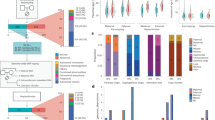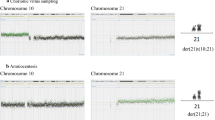Abstract
The frequencies of autosomal trisomies in extraembryonic human tissues were estimated in the cases of different abnormalities of prenatal development, from the confined placental mosaicism (CPM) with either relatively normal embryogenesis or restricted intrauterine growth to spontaneous abortion. A tissue-specific compartmentalization was found to be characteristic of cell lines with trisomies for individual autosomes. Analysis of various phenotypical effects of chromosomal aberrations associated with mosaicism is necessarily required to understand the mechanisms and factors responsible for tissue chromosomal mosaicism. Based on analysis of the cell karyotype during prenatal diagnosing of chromosome aberrations in tissues of both extraembryonic and embryonic origin, in 1996, Wolstenholme proposed a model of CPM for individual chromosomes. According to the model, the distribution of cell lines with autosomal trisomies between extraembryonic tissues depends on the ratio between meiotic and mitotic mutations early in embryonic development. However, the model cannot be used to study tissue chromosomal mosaicism in spontaneous abortions, because little information is available on cell karyotype in embryonic tissues themselves after intrauterine fetal death. In this work, a model of tissue-specific chromosomal mosaicism was suggested based on the data on cell karyotype determined in extraembryonic tissues alone, which can be helpful in evaluating the contribution of tissue chromosomal differences into the etiology of early intrauterine death. Along with the experimental evidence, comparative analysis of the two models indicated that the meiotic chromosome nondisjunction plays the major role in trisomy formation and the resultant spontaneous arrest of embryonic development. Other factors responsible for tissue-specific distribution of chromosomal aberrations are also discussed. These are differences in cell proliferative activity, as well as changes in compartmentalization and migration of cells with abnormal karyotypes.
Similar content being viewed by others
REFERENCES
Warburton, D., Yu, C.Y., Kline, J., and Stein, Z., Mosaic Autosomal Trisomy in Cultures from Spontaneous Abortions, Am. J. Hum. Genet., 1978, vol. 30, no. 6, pp. 609-617.
Kalousek, D.K. and Dill, F.J., Chromosomal Mosaicism Confined to the Placenta in Human Conceptions, Science, 1983, vol. 221, pp. 665-667.
Delozier-Blanchet, C.D., Cytogenetic Abnormalities and Placental Function, Rev. Fran. Gynecol. D'Obstetr., 1991, vol. 86, no. 12, pp. 723-729.
Kalousek, D.K., Current Topic: Confined Placental Mosaicism and Intrauterine Fetal Development, Placenta, 1994, vol. 15, pp. 219-230.
Simoni, G. and Sirchia, S.M., Confined Placental Mosaicism, Prenatal Diagnosis, 1994, vol. 14, pp. 1185-1189.
Wolstenholme, J., Confined Placental Mosaicism for Trisomies 2, 3, 7, 8, 9, 16, and 22: Their Incidence, Likely Origins and Mechanisms for Cell Lineage Compartmentalization, Prenatal Diagnosis, 1996, vol. 16, pp. 511-524.
Griffin, D.K., Millie, E.A., Redline, R.W., et al., Cytogenetic Analysis of Spontaneous Abortions: Comparison of Techniques and Assessment of the Incidence of Confined Placental Mosaicism, Am. J. Med. Genet., 1997, vol. 72, pp. 297-301.
Kalousek, D.K., Confined Placental Mosaicism and Uniparental Disomy, Funct. Dev. Morphol., 1994, vol. 4, no. 2, pp. 93-98.
Jonson, A. and Wapner, R.J., Mosaicism: Implication for Postnatal Outcome, Curr. Opin. Obstetr. Gynecol., 1997, vol. 9, no. 2, pp. 126-135.
Kalousek, D.K., Barrett, I.J., and Gartner, A.B., Spontaneous Abortions and Confined Placental Mosaicism, Hum. Genet., 1992, vol. 88, pp. 642-646.
Lombardi, S.J. and Dev, V.G., Cytogenetic Discrepancies in Spontaneous Abortions with Direct and Culture Analysis of Chorionic Villi, Am. J. Obstetr. Gynecol., 1992, vol. 170, p. 264.
Hassold, T., Hunt, P.A., and Sherman, S., Trisomy in Humans: Incidence, Origin and Etiology, Curr. Opin. Genet. Dev., 1993, vol. 3, no. 3, pp. 398-403.
Hassold, T., Chen, N., Funkhouser, J., et al., A Cytogenetic Study of 1000 Spontaneous Abortions, Ann. Hum. Genet., 1980, vol. 44, no. 2, pp. 151-178.
Eiben, B., Bartels, I., Bahr-Porsch, S., et al., Cytogenetic Analysis of 750 Spontaneous Abortions with the Direct-Preparation Method of Chorionic Villi and Its Implications for Studying Genetic Causes of Pregnancy Wastage, Am. J. Hum. Genet., 1990, vol. 47, pp. 656-663.
Lestou, V.S. and Kalausek, D.K., Confined Placental Mosaicism and Intrauterine Fetal Growth, Arch. Dis. Child. Fetal Neonatal Ed., 1998, vol. 79, pp. 223-226.
Takahara, H., Ohama, K., and Fujiwara, A., Cytogenetic Study in Early Spontaneous Abortions, Hiroshima J. Med. Sci., 1977, vol. 26, no. 4, pp. 291-296.
Kajii, T., Ferrier, A., Niikawa, N., et al., Anatomic and Chromosomal Abnormalities in 639 Spontaneous Abortuses, Hum. Genet., 1980, vol. 55, pp. 87-98.
Meulenbroeck, G.H.M. and Geraedts, J.P.M., Parental Origin of Chromosome Abnormalities in Spontaneous Abortions, Hum. Genet., 1982, vol. 62, pp. 129-133.
Guerneri, S., Bettio, D., Simoni, G., et al., Prevalence and Distribution of Chromosome Abnormalities in a Sample of First Trimester Internal Abortions, Hum. Reprod., 1987, vol. 2, no. 8, pp. 735-739.
Rehder, H., Coerdt, W., Eggert, R., et al., Is There a Correlation between Morphological and Cytogenetic Findings in Placental Tissue from Early Missed Abortions?, Hum. Genet., 1989, vol. 82, no. 4, pp. 377-385.
Ohno, M., Maeda, T., and Matsunobi, A., A Cytogenetic Study of Spontaneous Abortions with Direct Analysis of Chorionic Villi, Obstetr. Gynecol., 1991, vol. 77, pp. 394-398.
Minelli, E., Buchi, C., Granata, P., et al., Cytogenetic Findings in Echographically Defined Blighted Ovum Abortions, Ann. Genet., 1993, vol. 36, no. 2, pp. 107-110.
Be, C.R., Velasquez, P.M., and Youlton, R.R., A Cytogenetic Study in 609 Abortions, Rev. Med. Chile, 1997, vol. 125, pp. 317-322.
Brajenovic-Milic, B., Petrovic, O., Krasevic, M., et al., Chromosomal Abnormalities in Abnormal Human Pregnancies, Fetal Diagnosis Therapy, 1998, vol. 13, no. 3, pp. 187-191.
Crane, J.P. and Cheung, S.W., An Embryonic Model to Explain Cytogenetic Inconsistencies Observed in Chorionic Villus versus Fetal Tissue, Prenatal Diagnosis, 1988, vol. 8, no. 2, pp. 119-129.
Hahnemann, J.M. and Vejerslev, L.O., European Collaborative Research on Mosaicism in CVS (EUROCROMIC) —Fetal and Extrafetal Cell Lineages in 192 Gestations with CVS Mosaicism Involving Single Autosomal Trisomy, Am. J. Med. Genet., 1997, vol. 70, pp. 179-187.
Robinson, W.P., Bernasconi, F., Lau, A., and McFadden, D.E., Frequency of Meiotic Trisomy Depends on Involved Chromosome and Mode of Ascertainment, Am. J. Med. Genet., 1999, vol. 88, pp. 34-42.
Zaragoza, M.V., Millie, E., Redline, R.W., and Hassold, T.J., Studies of Nondisjunction in Trisomies 2, 7, 15, and 22: Does the Parental Origin of Trisomy Influence Placental Morphology?, J. Med. Genet., 1998, vol. 35, pp. 925-931.
Kalousek, D.K., Langlois, S., Robison, W.P., et al., Trisomy 7 CVS Mosaicism: Pregnancy Outcome, Placental and DNA Analyses in 14 cases, Am. J. Med. Genet., 1996, vol. 65, pp. 348-352.
De Brasi, D., Genuardi, M., D'Agostino, A., et al., Double Autosomal/Gonosomal Mosaic Aneuploidy: Study of Nondisjunction in Two Cases with Trisomy of Chromosome 8, Hum. Genet., 1995, vol. 95, pp. 519-525.
James, R.S. and Jacobs, P.A., Molecular Studies of the Etiology of Trisomy 8 in Spontaneous Abortions and the Liveborn Population, Hum. Genet., 1996, vol. 97, no. 3, pp. 283-286.
Karadima, G., Bugge, M., Nicolaidis, P., et al., Origin of Nondisjunction in Trisomy 8 and Trisomy 8 Mosaicism, Eur. J. Hum. Genet., 1998, vol. 6, pp. 432-438.
Wilkinson, T.A., James, R.S., Crolla, J.A., et al., A Case of Maternal Uniparental Disomy of Chromosome 9 in Association with Confined Placental Mosaicism for Trisomy 9, Prenatal Diagnosis, 1996, vol. 16, no. 4, pp. 371-374.
Nicolaidis, P. and Petersen, M.B., Origin and Mechanisms of Nondisjunction in Human Autosomal Trisomies, Hum. Reprod., 1998, vol. 13, no. 2, pp. 313-319.
Bischoff, F.Z., Zenger-Hain, J., Moses, D., et al., Mosaicism for Trisomy 12: Four Cases with Varying Outcomes, Prenatal Diagnosis, 1995, vol. 15, no. 11, pp. 1017-1026.
Hassold, T. and Takaesu, N., Analysis of Nondisjunction in Human Trisomic Spontaneous Abortions, Progr. Clin. Biol. Res., 1989, vol. 311, pp. 115-134.
Zaragoza, M.V., Jacobs, P.A., James, R.S., et al., Nondisjunction of Human Acrocentric Chromosomes: Studies of 432 Fetuses and Liveborns, Hum. Genet., 1994, vol. 94, pp. 411-417.
Hassold, T., Jacobs, P.A., Lepert, M., and Sheldon, M., Cytogenetic and Molecular Studies of Trisomy 13, J. Med. Genet., 1987, vol. 24, pp. 725-732.
Cristian, S.L., Smith, A.C.M., Black, C., et al., Prenatal Diagnosis of Uniparental Disomy 15 Following Trisomy 15 Mosaicism, Prenatal Diagnosis, 1996, vol. 16, pp. 323-332.
Trisomy 15 CPM: Probable Origins, Pregnancy Outcome and Risk of Fetal UD: European Collaborative Research on Mosaicism in CVS, Prenatal Diagnosis, 1999, vol. 19, no. 1, pp. 29-35.
Hassold, T., Pettay, D., Freeman, S.D., et al., Molecular Studies of Nondisjunction in Trisomy 16, J. Med. Genet., 1991, vol. 28, pp. 159-162.
Hassold, T., Merrill, M., Adkins, K., et al., Recombination and Maternal-Age Dependent Nondisjunction: Molecular Studies of Trisomy 16, Am. J. Hum. Genet., 1995, vol. 57, pp. 867-874.
Robinson, W.P., Barrett, I.J., Bernard, L., et al., Meiotic Origin of Trisomy in Confined Placental Mosaicism Is Correlated with Presence of Fetal Uniparental Disomy, High Levels of Trisomy in Trophoblast and Increased Risk of Fetal Intrauterine Growth Restriction, Am. J. Hum. Genet., 1997, vol. 60, pp. 917-927.
Genuardi, M., Tozzi, C., Pomponi, M., et al., Mosaic Trisomy 17 in Amniocytes: Phenotypic Outcome, Tissue Distribution, and Uniparental Disomy Studies, Eur. J. Hum. Genet., 1997, vol. 7, pp. 421-426.
Fisher, J.M., Harvey, J.F., Morton, N.E., and Jacobs, P.A., Trisomy 18: Studies of the Parent and Cell Division of Origin and the Effect of Aberrant Recombination on Nondisjunction, Am. J. Hum. Genet., 1995, vol. 56, no. 3, pp. 669-675.
Bugge, M., Collins, A., Petersen, M.B., et al., Nondisjunction of Chromosome 18, Hum. Mol. Genet., 1998, vol. 7, pp. 661-668.
Lamb, N.E., Freeman, S.B., Savage-Austin, A., et al., Susceptible Chiasmata Configurations of Chromosome 21 Predispose to Nondisjunction in Both Maternal Meiosis I and Meiosis II, Nat. Genet., 1996, vol. 14, pp. 400-405.
Pangalos, C., Avramopoulos, D., Blouin, J., et al., Understanding Mechanism(s) of Mosaic Trisomy 21 by Using DNA Polymorphism Analysis, Am. J. Hum. Genet., 1994, vol. 60, pp. 917-927.
Sherman, S.L., Takaesu, N., Freeman, S.B., et al., Trisomy 21: Association between Reduced Recombination and Nondisjunction, Am. J. Hum. Genet., 1991, vol. 49, no. 3, pp. 608-620.
Bacino, C.A., Schreck, R., Fischel-Ghosdian, N., et al., Clinical and Molecular Studies in Full Trisomy 22: Further Delineation of the Phenotype and Review Literature, Am. J. Med. Genet., 1995, vol. 56, pp. 359-365.
Wapner, R., Jackson, L., Davies, G., et al., Cytogenetic Discrepancies Found at Chorionic Villus Sampling, Am. J. Hum. Genet., 1985, vol. 37, p. A122.
Ledbetter, D.H., Zachary, J.M., Simpson, J.L., et al., Cytogenetic Results from UK Collaborative Study on CVS, Prenatal Diagnosis, 1992, vol. 12, pp. 317-345.
Wolstenholme, J., Rooney, D.E., and Davison, E.V., Confined Placental Mosaicism, IUGR and Adverse Pregnancy Outcome: A Controlled Retrospective UK Collaborative Study, Prenatal Diagnosis, 1994, vol. 14, pp. 345-361.
Warburton, D. and Kinney, A., Chromosomal Differences in Susceptibility to Meiotic Aneuploidy, Environ. Mol. Mutagen., 1996, vol. 28, no 3, pp. 237-247.
Persutte, W.H. and Lenke, R.P., Failure of Amniotic-Fluid Cell Growth: Is It Related to Fetal Aneuploidy?, Lancet, 1995, vol. 345, pp. 96-97.
Reid, R., Sepulveda, W., Kyle, P.M., and Davies, G., Amniotic Fluid Culture Failure: Clinical Significance and Association with Aneuploidy, Obstetr. Gynecol., 1996, vol. 87, pp. 588-592.
Miller, K., Metze, V., Wang, R., et al., Proliferation Kinetics of Chorionic Villi in Chromosomally Normal and Abnormal Spontaneous Abortions Analyzed by Premature Chromosome Condensation and Northern Blot, Ann. Genet., 1996, vol. 39, no. 3, pp. 159-167.
James, R.M. and West, J.D., A Chimeric Animal Model for Confined Placental Mosaicism, Hum. Genet., 1994, vol. 93, pp. 603-604.
Everett, C.A. and West, J.D., Evidence for Selection Against Tetraploid Cells in Tetraploid Diploid Mouse Chimeras before the Late Blastocyst Stage, Genet. Res., 1998, vol. 72, no. 3, pp. 225-228.
Henderson, K.G., Shaw, T.E., Barren, I.J., et al., Distribution Mosaicism in Human Placentas, Hum. Genet., 1996, vol. 97, pp. 650-654.
Markert, C.L. and Petters, R.M., Manufactured Hexaparental Mice Show That Adults Are Derived from Three Embryonic Cells, Science, 1978, vol. 202, pp. 56-58.
Author information
Authors and Affiliations
Rights and permissions
About this article
Cite this article
Lebedev, I.N., Nazarenko, S.A. Tissue-Specific Placental Mosaicism for Autosomal Trisomies in Human Spontaneous Abortuses: Mechanisms of Formation and Phenotypical Effects. Russian Journal of Genetics 37, 1224–1237 (2001). https://doi.org/10.1023/A:1012544706246
Issue Date:
DOI: https://doi.org/10.1023/A:1012544706246




